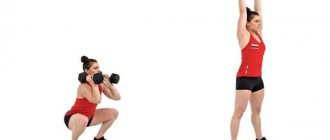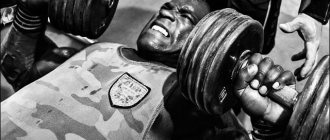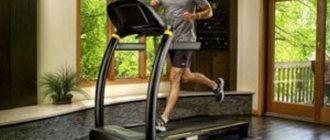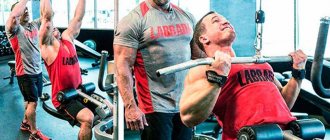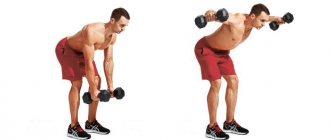Share:
What you need
- Weight
Swinging kettlebells with two hands is an exercise that came to CrossFit from kettlebell lifting. And if in kettlebell lifting the performance of this exercise is of an auxiliary nature for the development of strength and endurance in exercises such as the snatch and jerk of weights, then in functional training its purpose is somewhat different.
Swinging kettlebells with two hands is a basic exercise that involves almost all muscle groups, increases the explosive strength of the legs and shoulder girdle, and when combined with other basic exercises within one complex, contributes to a tremendous increase in strength endurance.
Today we will discuss the following points:
- Why is it used?
- What muscle groups does this exercise work?
- Technique for performing the exercise and errors that occur during execution.
- The benefits of this exercise.
- CrossFit complexes, which include two-handed kettlebell swings.
Execution technique
Initial position
- The kettlebell is placed on the floor between the legs;
- The toes of the feet are anatomically conveniently turned out, the knees are aligned with the toes;
- The entire “design” of the stance is determined by the attachment of the femur, and not by how much the feet of models in the ideal universe are turned out in textbook pictures. You need to stand as comfortably as possible;
- The kettlebell is placed in the middle of the arch of the feet;
- To fall off the platform, you need to grab the handle with both hands, bend your knees so that your back remains straight, and bending occurs only in the knee and hip joint;
- Due to partial extension at the knee joint, the weight is removed from the platform, the back remains straight;
- Next, you should swing, bending at the hip joints so that the projectile goes behind the shins, back.
Movement
- Due to sharp and simultaneous extension in the knee and hip joints, the projectile is pushed forward;
- The arms remain relaxed enough that the shoulders do not pull the weight upward;
- The knees straighten completely, the hips too;
- As soon as the weight has reached waist level, you should begin to bend your knees and hips, returning to the starting position;
- The exercise is repeated for the required number of repetitions, then the projectile is stopped with your hands and lowered to the ground.
Swing the kettlebell in front of you: 2 options
Attention
- A slouched back is a cause of injury . The lower back should be tense and arched and without humps, otherwise the risk of injury increases significantly;
- The kettlebell swing is one of the few exercises performed by inertia, which means that it is not recommended to pull the projectile up with your hands, your hands are excluded from the movement as much as possible, and the kettlebell simply hangs in them;
- It is necessary to exclude squatting with a vertical back and bent knees. The movement is more like a deadlift than a squat, so you'll want to avoid any movements that look like a squat. An indicator of the correctness of the movement is that in a correct kettlebell swing, the bottom of the projectile does not touch the floor until the exercise is completed;
- This is a swinging inertial movement. There is no need to forcefully stop the weight with your hands or body and try to make points along the entire path of the trajectory;
Most common mistakes
- Neglecting warm-up. The shoulders are one of those muscle groups that can be very easily injured, so warming up your deltoids and your entire body should be an important part of your workout.
- Lifting your heels off the floor will cause you to lose control of your movement and cause your back to round, which can lead to injury.
- Perform the exercise if you have pain in the shoulders or back. Wait until your joints and muscles are completely healed, otherwise you may make the situation worse.
Recommendations
- You need to tighten your stomach and strain your back so that the static tension keeps the spine in approximately the same position;
- The movement is inertial, that is, it is based on a push with the hips, but the kettlebell moves not because it is lifted up with the hands, but because the body and arms are pushed with the hips;
- The movement can be developed by pulling a rubber shock absorber between the legs, so its jerky nature will be more clear if it is not possible to work with a light weight. The shock absorber is attached to a vertical support, and is pulled between the legs, grabbed by the hands, then extension is performed in the knee and hip joints at the same time. This exercise helps to develop the mechanics of the movement; when it becomes successful, you can add weights too;
- Lowering the weight should not be accompanied by rounding your shoulders forward and relaxing your back;
- Do not throw your head back; a neutral head position is the key to success in this exercise;
Overhead Squat Press
This variation of the kettlebell press is a powerful exercise that works the upper and lower parts of your body, thereby strengthening them. The overhead squat press is a complete workout that works every muscle in the body. This is one of the best strength exercises that doesn't require much equipment but produces phenomenal results. This load will also provide a much better core workout, which will challenge not only beginners but also experienced athletes.
Performance:
1) lift the weight so that it can swing between your legs; 2) the exercise begins at the bottom point with a sweeping movement; 3) with a movement similar to an uppercut, pull the weight to your chest; it should end up between the biceps and forearm (kettlebell-on-chest position); 4) from this position, push the kettlebell up, fully aligning your arm and locking your elbow at the top of the exercise; then lower the weight back to your chest; 5) smoothly lower the weight down to the starting position; begin the next repetition without jerking.
Advice. Make sure that the weight does not turn upside down; it only changes its position during the uppercut.
Execution options
- With one hand . Performed technically in the same style as two-arm swings, the additional work of stabilizing the back and shoulder falls on the core muscles;
- "American" swings . Performed in full amplitude. Due to inertia, the athlete pushes the weight from the hips to the head, and, as it were, throws it back. More involved core and back, but not intended for beginners who do not know how to work their hips
- Swings with changing hands . A swing with one hand is performed and the projectile is intercepted by the handle in the air at waist level.
Crossfit exercises! Swing the kettlebell! Mikhail Prygunov
Press
All abdominal exercises with kettlebells are not suitable for beginners, who first need to learn how to perform them correctly with their own weight and only then gradually increase them.
Crunches
This is a classic version of crunches on the floor, only with additional weights. It is most convenient to hold the projectile on the chest with two hands. Don’t forget that when doing crunches, you don’t need to lift your lower back off the floor—only the shoulder girdle, while rounding your spine and straining your abs.
© ifitos2013 — stock.adobe.com
Reverse crunches
This is a heavier version of reverse crunches - when you do not pull your body towards your stationary legs, but, on the contrary, raise your bent legs, lift your buttocks and lift them up, straining your lower abs.
Here you can hold the weights with your arms outstretched in front of you:
© ifitos2013 — stock.adobe.com
Side plank
Here the oblique abdominal muscles work statically. The kettlebell can be held with your free hand at the shoulder or on your arm extended upward. You can stand in the plank either on your elbow or on a straight arm.
© ifitos2013 — stock.adobe.com
Corner on kettlebells
An excellent exercise for the rectus abdominis muscle. The technique is:
- Place the implements shoulder-width apart so that when you lean on them, your arms are perpendicular to the floor.
- Sit between the apparatus, stretch your legs forward, grasp the handles of the weights, straighten your arms. The pelvis should lift off the floor.
- Raise your legs up so that an angle of 90 degrees is formed between them and the body, and hold for as long as possible.
© grki — stock.adobe.com
Analysis of the exercise
What muscles work
- The main movers are the biceps and quadriceps of the thighs, the entire array of the gluteal muscles, as well as the extensors of the spine
- Stabilizers – abdominal muscles, latissimus, soleus, trapezius, forearm muscles, as well as palm and deltoids muscles
pros
- Promotes weight loss. One of the few simple metabolic exercises that is suitable for both beginners and intermediates, it helps speed up your metabolism. Suitable for hybrid interval training that combines the benefits of cardio and strength work. They are almost always performed at a high heart rate;
- They are performed in inertial mode and simultaneously train coordination and endurance, as well as strength. It is recommended to perform swings with a kettlebell that weighs about a third of your body weight in order to achieve maximum effect;
- Strengthen the entire muscle corset and help develop grip strength for more difficult exercises;
- Excellent development of deadlift mechanics;
- Suitable for people of all ages, men and women;
- Allows you to develop the cardiovascular system, suitable as a “transitional” exercise between strength work and endurance training
Flaws
- Requires good coordination;
- They force you to work on your technique;
- With a classic set of weights, it is difficult to progress in strength, since the weight increment of the projectile is too large - 8, 16.24 and 36 kg. Therefore, for those who do not have access to CrossFit weights with finer pitches, it is recommended to turn on the rubber when the equipment has become too light
Preparation
The movement is highly coordinated and multi-joint, so the warm-up must be thorough and include several blocks. Warming up with cardio before swings is mandatory, as movement loads the cardiovascular system. It is enough to walk or run until you sweat lightly.
Swings should stand apart from exercises that fully load the lower back. It is not recommended to combine them in the same plan with movements like heavy good mornings, stiff-legged deadlifts with significant weight, and weighted hyperextensions. Can be combined in one plan. But then something has to be easy.
Proper execution
- The first thing they teach in kettlebell fitness classes is to relax your arms and trapezius. Although they work as stabilizers in this movement, you should not use them excessively, much less lift the weight with your hands;
- The movement can be performed as an American swing, that is, behind the head, or a Russian one, but beginners should in any case start with the Russian in order to develop the correct mechanics of the movement;
- Inhalation is done while lowering, exhalation is done during the swing itself. The exercise is performed using breathing, among other things, it does not need to be held as in deadlifts and other strength exercises;
- You need to try to avoid undersquatting as in a squat, it leads to the bottom of the weight touching the floor;
- You should avoid holding the weights on your fingertips; it is better to keep a full palm grip;
- When lifting the projectile, you should keep your arms as if springy, as straight as possible, but at the same time do not “insert” your elbows
Errors
- Squats like in a squat;
- Bent hands and elbows;
- Lifting weights using deltas;
- Slouched back;
- Relaxed stomach;
- Insufficient work of the hips, attempt to push the projectile only due to extension in the knee joint
Efficiency Tips
- Although breathing is not held completely, not partially releasing air from the lungs helps in keeping the core rigid, and therefore in protecting the spine from injury;
- The arms should not try to lift the weight, but they should not bend or straighten the elbows either; it is best to keep them steadily relaxed;
- At the start, you should not place the kettlebell too far behind you; if you have poor mobility, there is a risk of breaking your back;
From Russian swings to American ones
The technique of the Russian kettlebell swing was given above. It is considered safer for fitness. But in CrossFit, an American swing is performed, with the weight placed behind the head. It uses more muscles and requires a powerful kick from the legs at the start.
A sharp extension in the knees and pelvis allows you to swing the projectile behind your head. The weight reaches the chest by inertia, and the athlete begins to lift the body under the weight, as in a weightlifting snatch. The movement involves rotation in the shoulder joints, but the elbows should be moderately straight.
In the American swing, a slightly wider position of the palms on the kettlebell handle is practiced; the athlete can literally hold on to the corners of the handle. It is important not to relax your abs to prevent an unstable position of the spine. Training in the American swing begins only after the athlete’s shoulder joints have fully “opened,” that is, in a standing position, he can painlessly place his straight arm behind his head without performing a circle with his arm.
Swings can be included in a classic leg or back workout and performed 1-2 times a week.
Inclusion in the program
The exercise is included as the first if we have a beginner in front of us who is just learning the technique. It is believed that women should start learning it from 8 kg, and men from 16, but this is not a hard rule, but just a recommendation.
The exercise is not done in a multi-repetition mode at first, starting with 5-6 sets of 10-12 repetitions. Then you can switch to a more “aerobic” high-repetition mode and move more.
Often kettlebell exercises are performed not for repetitions, but according to a timer, this allows you to concentrate on technique, and not on counting the number of swings.
Standing still is a step backwards
Serious tests are vitally necessary for a person. We only grow when we push boundaries, achieve goals and break personal records. We do everything better, we look great and enjoy life.
In everyday life, we either progress or regress.
There is no “maintenance” phase. Moderation in training quickly turns into stagnation. And in general, moderation is for the weak. Therefore, if we want to improve, we must look for new challenges, fight and win. The training program “10,000 kettlebell swings” is just such a test, or, as it is now fashionable to say, a challenge. And it can significantly improve your physical condition in just four weeks.
Proven results
Dan John didn't create this program at his desk. He developed and tested it in real conditions with real people.
To create and perfect this program, he met and discussed results with eighteen other athletes and coaches over many weeks. Here's what they observed:
- After 20 workouts, all participants showed a decrease in body fat percentage. The waist circumference decreased by 1 (and for some by 2) sizes.
- All athletes gained muscle mass.
- After completing the challenge, all participants increased their grip strength and endurance. They were able to train longer and harder when they returned to their regular workouts.
- After returning to normal training, many noticed a noticeable improvement in their results in almost all exercises. Many personal bests were set.
- The abdominal muscles became more noticeable, but the strength of the gluteal muscles increased the most. All this significantly affected the improvement of sports results.


